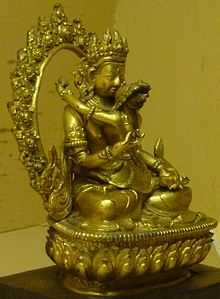User:AD64/Sandbox 2
Sandbox for revising section on Padmasambhava's five main consorts[edit]
Consorts and twenty five main disciples[edit]
Many of those who gathered around Padmasambhava became advanced tantric practitioners as well as helping to found and propagate the Nyingma tradition. The most prominent of these include Padmasambhava's five main female consorts, also known as dakinis and his twenty five main disciples.
The five main consorts or five wisdom dakinis[edit]

Padmasambhava had five main female tantric companions, beginning in India before his time in Tibet and then in Tibet as well. When seen from an outer, or perhaps even historical or mythological perspective, these five women from across South Asia were known as the Five Consorts. That the women come from very different geographic regions is understood as mandala, a support for Padmasambhava in spreading the dharma throughout the region.
Yet, when understood from a more inner tantric perspective, these same women are understood not as ordinary women but as dakinis; from this point of view, they are known as the "Five Wisdom Dakinis" (Wylie: Ye-shes mKha-'gro lnga). Each of these consorts is believed to be an an emanation of the tantric yidam, Vajravārāhī.[1] As one author writes of these relationships:
Yet in reality, he [Padmasambhava] was never separate from the five emanations of Vajravarahi: the Body-emanation, Mandarava; the Speech-emanation, Yeshe Tsogyal; the Mind-emanation, Shakyadema; the Qualities-emanation, Kalasiddhi; and the Activity-emanation, Trashi [sic] Chidren.[2]
In summary, the five consorts/wisdom dakinis were:
- Yeshe Tsogyal of Tibet, who was the emanation of Vajravarahi's Speech;
- Mandarava of Zahor, northeast India, who was the emanation of Vajravarahi's Body;
- Belwong Kalasiddhi of northwest India, who was the emanation of Vajravarahi's Quality;
- Belmo Sakya Devi of Nepal, who was the emanation of Vajravarahi's Mind; and
- Tashi Kyedren (or Chidren) (sometimes called Mangala) of Bhutan, who was the emanation of Vajravarahi's Activity.
While there are very few sources on the lives of Kalasiddhi, Sakya Devi, and Tashi Kyedren, there are extant biographies of both Yeshe Tsogyal and Mandarava that have been translated into English and other western languages.
UNUSED MATERIAL BELOW
Princess Yeshe Tsogyal of Tibet[edit]
Princess Mandarava of northeast India[edit]
Belwong Kalasiddhi of northwest India[edit]
Belmo Sakya Devi from Nepal[edit]
On Padmasambhava's consort practice with Princess Sakya Devi from Nepal it is said:
In a state of intense bliss, Padmasambhava and Sakyadevi realized the infinite reality of the Primordial Buddha Mind, the All-Beneficent Lord (Samantabhadra), whose absolute love is the unimpeded dynamo of existence. Experiencing the succession of the four stages of ecstasy, their mutual state of consciousness increased from height to height. And thus, meditating on Supreme Vajrasattva Heruka as the translucent image of compassionate wrathful (energized) activity, they together acquired the mahamudra of Divinity and attained complete Great Enlightenment.[3]
Mangala (Tashi Kyedren) of the Himalayas[edit]
AD64 (talk) 01:43, 5 May 2016 (UTC)
- ^ Dowman, Keith. (1984). Sky Dancer: The Secret Life and Songs of the Lady Yeshe Tsogyel. p. 265.
- ^ Gyalwa Changchub and Namkhai Nyingpo, ‘’Lady of the Lotus-Born: The Life and Enlightenment of Yeshe Tsogyal’’, Shambhala (1999, pp. 3-4)
- ^ Dharma Fellowship of His Holiness the Gyalwa Karmapa Lord Padmasambhava: Embodiment of all the Buddhas Section 9.
